Ayres Wins Wisconsin APWA Award for Historic Bridge Rehabilitation Project
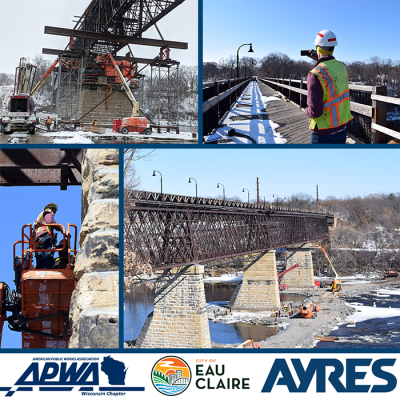 The Wisconsin Chapter of the American Public Works Association (APWA) has presented Ayres with a 2023 Project of the Year Award in the Historical Restoration/Preservation category for a rehabilitation project completed on the High Bridge in Eau Claire. The APWA uses these awards to recognize the strong alliance between the managing agency, the consultant/architect/engineer, and the contractor to effectively complete public works projects. Ayres partnered with the City of Eau Claire and Kraemer North America on the project to correct the iconic bridge’s structural issues within an accelerated timeline while also addressing numerous environmental, logistical, and aesthetic considerations.
The Wisconsin Chapter of the American Public Works Association (APWA) has presented Ayres with a 2023 Project of the Year Award in the Historical Restoration/Preservation category for a rehabilitation project completed on the High Bridge in Eau Claire. The APWA uses these awards to recognize the strong alliance between the managing agency, the consultant/architect/engineer, and the contractor to effectively complete public works projects. Ayres partnered with the City of Eau Claire and Kraemer North America on the project to correct the iconic bridge’s structural issues within an accelerated timeline while also addressing numerous environmental, logistical, and aesthetic considerations.
Ayres had the honor of providing the City with design services that have put the Chicago Northwestern Chippewa River Bridge, more familiarly known simply as the “High Bridge,” on firm footing again after deterioration of one of the rail bridge’s 140-year-old piers left the signature bridge’s future in doubt in 2021. The bridge reopened to the public in March of 2022.
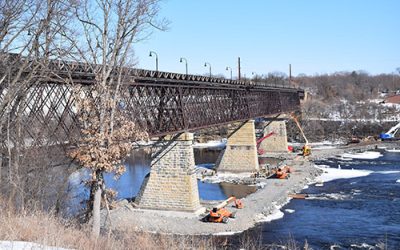
Having designed the 2015 conversion of the bridge – built over the Chippewa River in Eau Claire in 1881 – to pedestrian use with a new timber deck and railings, Ayres sprang into action after the City closed the bridge in June 2021 when a failure was discovered at the top of the bridge’s middle pier. Stones on the north and south ends of the limestone and sandstone pier had failed directly under the bearings at the bottom of one of the bridge’s massive 450,000-pound main spans. That left this span resting precariously on the compromised pier.
The bridge, which affords pedestrians and bicyclists stunning views from high above the river between First Street and Forest Street just north of downtown, is on the National Register for Historic Places. The bridge is approximately 898 feet long, including two 80-foot double intersection Warren deck trusses at the approaches and four 180-foot main spans that are believed to be the only quintuple intersection lattice deck trusses in the nation.
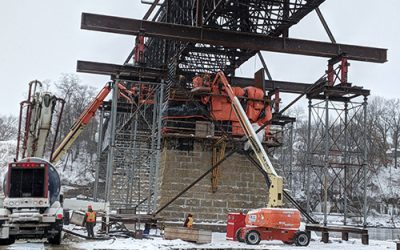
Deeming the bridge important enough to mount an extraordinary effort to save it, the City immediately called upon Ayres, with its previous knowledge of the bridge, to provide initial advice on the bridge’s condition and then to provide accelerated design services, prepare plans for repairs, and observe the work of contractor Kraemer North America. It was imperative that all this critical design and construction take place between the June 2021 discovery and March 2022, when the Chippewa River’s high spring flows generally begin. Repairs required building a rock causeway across much of the river to allow construction equipment to be positioned mid-river through the fall and winter. Spring flooding would threaten the rock causeway and the environment surrounding it if it were washed away. The work of the City, Ayres, and Kraemer met that deadline.
The rapid design work resulted in detailed plans for the replacement of approximately the top 40% of the affected pier after Kraemer constructed temporary shoring towers to take the load of the massive truss off the pier. Ayres’ pier design replaced the top portion of the pier with steel reinforced concrete. The exterior of the concrete was stamped in a pattern to resemble the limestone and sandstone used to construct the 1881 piers.
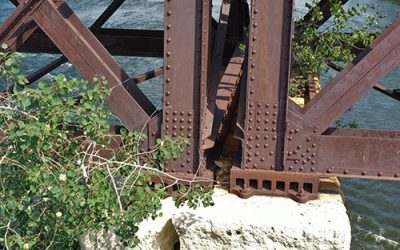
In addition, the top several feet of the bridge’s other two rock piers were encapsulated and reinforced by placing poured-in-place, steel-rebar-reinforced collars around the tops of those piers. Joints between the rock slabs of all three piers were also tuck-pointed to mitigate future weathering. The bearings throughout the bridge were refurbished to make them function better amid changing temperatures that cause the steel structure to expand and contract. Also, reinforced concrete collars were poured at the base of the piers to address undermining that was beginning to occur just below the waterline.
Among the major challenges of this emergency project was the lack of original construction drawings from 1881. Drawings can generally be found for bridges as old as 80 years, but not so with such old railroad bridges. So there was uncertainty about the makeup of the piers until construction began. Was there sand at their core? They turned out to be solid rock slabs throughout. Having the railroad structural division of Kraemer on the team provided critical background on issues the team needed to watch for on the old bridge. As discoveries were made during construction, Ayres was on site to provide expert guidance and adjust design details where necessary.
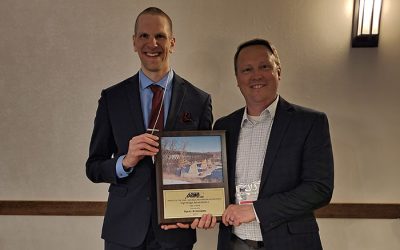
The causeway was constructed to enable work operations to remain within a narrow footprint under the bridge. Just downstream from the bridge is one of the best fishing holes in the city. Utmost care was taken to ensure that fishing activities were maintained throughout the duration of the project and sediment did not negatively impact the site.
Dan Sydow, manager of structural engineering at Ayres, says his hometown team takes pride in the clutch work they provided to save the bridge.
“We live, work, and play here, and our engineers and technicians were so honored to provide one-of-a-kind solutions to keep this one-of-a-kind, historic bridge in service so that many more residents and visitors can enjoy the views it provides,” Sydow said.
The entire team of city staff, design consultants, and contractors recognized that they were racing against the clock in hopes of saving the High Bridge before it failed further. The cooperation resulted in improvements to the bridge that may be enjoyed by the community for years to come.
